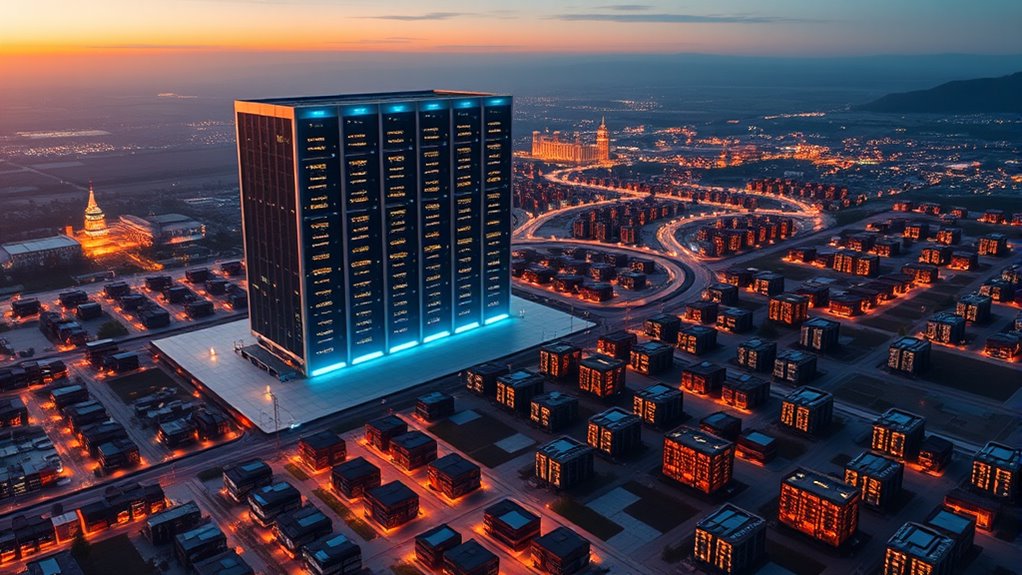Choosing between edge and core data centers depends on your workload’s needs for low latency, security, and compliance. If your applications require real-time responses or localized processing, hosting them at the edge is best. For large-scale data analysis or high-security tasks, core data centers offer more power and control. To optimize performance and compliance, many organizations use both. Continue exploring to discover how to best match your workloads with the right infrastructure.
Key Takeaways
- Deploy latency-sensitive workloads at the edge to minimize delays and improve real-time responsiveness.
- Use core data centers for high-capacity, complex processing, and large-scale data analysis.
- Consider data sovereignty and compliance; edge offers localized processing, while core ensures centralized control.
- Combine both for optimal workload placement based on performance needs and regulatory requirements.
- Evaluate workload characteristics—edge for immediacy and local data, core for scalability and security.

As data demands grow and technology evolves, understanding the differences between edge and core data centers becomes essential. When deciding where to host your workloads, you need to consider how each type affects performance, security, and compliance. Edge data centers are smaller facilities positioned close to where data is generated and consumed. This proximity allows for significant latency reduction, ensuring that real-time applications like IoT devices, autonomous vehicles, or live streaming services operate smoothly. If your business relies on instant data processing, deploying workloads at the edge can drastically improve response times and user experience.
On the other hand, core data centers are larger, centralized facilities that handle vast amounts of data and complex processing tasks. They are optimized for high capacity, scalability, and robust security measures. When it comes to data sovereignty, core data centers often present both advantages and challenges. Because they are typically located in specific regions or countries, they can help guarantee compliance with local data regulations and standards. Storing sensitive data in a core data center allows for better control over data governance, especially when dealing with legal requirements around privacy and data residency.
Core data centers offer scalability and security but pose challenges for data sovereignty and regional compliance.
Deciding where your workloads should live involves weighing these factors. If your operations demand rapid data exchange, minimal latency, and local data processing, edge computing is likely the better fit. It enables you to process data close to its source, reducing delays and avoiding bottlenecks that can occur when data has to travel to distant core facilities. This setup is especially beneficial in scenarios where split-second decisions are crucial, such as in manufacturing automation or remote healthcare.
Conversely, if your needs center around large-scale data analysis, archival, or centralized management, a core data center might be more appropriate. These facilities excel in handling high-volume workloads, offering economies of scale, advanced security, and compliance capabilities. They also support disaster recovery and backup strategies more effectively, ensuring your data remains protected and accessible.
Ultimately, the decision isn’t about choosing one over the other but rather understanding how each aligns with your workload requirements. For latency-sensitive, localized tasks, edge computing reduces delays and enhances data sovereignty by keeping data within specific jurisdictions. For extensive, resource-intensive processes, a core data center provides the capacity and security needed to manage your data effectively. By evaluating your application’s performance needs and regulatory obligations, you can determine the best placement for your workloads, leveraging both edge and core infrastructure to meet your strategic goals.
A key consideration in the deployment of data centers is the contrast ratio, which significantly impacts the quality and clarity of visual displays, especially in high-end home cinema setups.
Frequently Asked Questions
How Does Latency Impact Workload Placement Decisions?
Latency impacts your workload placement decisions because high latency can hinder latency-sensitive applications, reducing workload responsiveness. If your workloads require real-time data processing or quick responses, placing them closer to users or data sources minimizes delays. Conversely, less latency-sensitive tasks can be hosted in core data centers. Understanding your workload’s responsiveness needs helps you decide whether to prioritize edge locations for low latency or centralized sites for efficiency.
What Are the Cost Differences Between Edge and Core Data Centers?
When comparing costs, you find that edge data centers typically have higher operational expenses due to their smaller size and need for specialized hardware. Core data centers benefit from economies of scale, reducing overall costs per workload. You should consider this cost comparison when planning your infrastructure, as edge centers can be more expensive to operate but offer lower latency, while core centers are more cost-efficient for large-scale workloads.
How Scalable Are Edge Data Centers for Growing Businesses?
Imagine your business as a growing tree; edge expansion acts as new branches reaching outward. Edge data centers are highly scalable for your growth, allowing you to implement scalability strategies like modular designs and remote management. This flexibility helps you adapt quickly, supporting increased data demands without overextending. As your business blossoms, edge infrastructure can expand with you, ensuring your workloads stay close and responsive, no matter how tall you grow.
What Security Challenges Are Unique to Edge Data Centers?
You face unique security challenges at edge data centers, mainly due to distributed security concerns and physical vulnerabilities. Since these centers are often spread out, protecting data across multiple locations becomes complex, increasing the risk of breaches. Physical vulnerabilities, like limited security measures at remote sites, make them easier targets for tampering or theft. You need robust security protocols and physical safeguards to mitigate these risks effectively.
How Do Regulatory Requirements Influence Data Center Location Choices?
Regulatory requirements heavily influence your data center location choices. You need to contemplate data sovereignty laws that mandate data stay within specific jurisdictions, ensuring compliance standards are met. These regulations can restrict where you store and process sensitive data, prompting you to choose locations that align with legal obligations. By understanding local laws, you can avoid penalties, safeguard customer trust, and ensure your data management practices remain compliant with regional and international standards.
Conclusion
Choosing between edge and core data centers is like picking the right tool for the job—you need both, but for different reasons. Think of edge as your speedy courier, bringing data close to users, while core is your sturdy backbone, managing heavy lifting. By understanding where your workloads thrive best, you guarantee your data’s journey is smooth and efficient. Ultimately, aligning your infrastructure with your needs keeps your digital world spinning seamlessly—like gears in a well-oiled machine.









